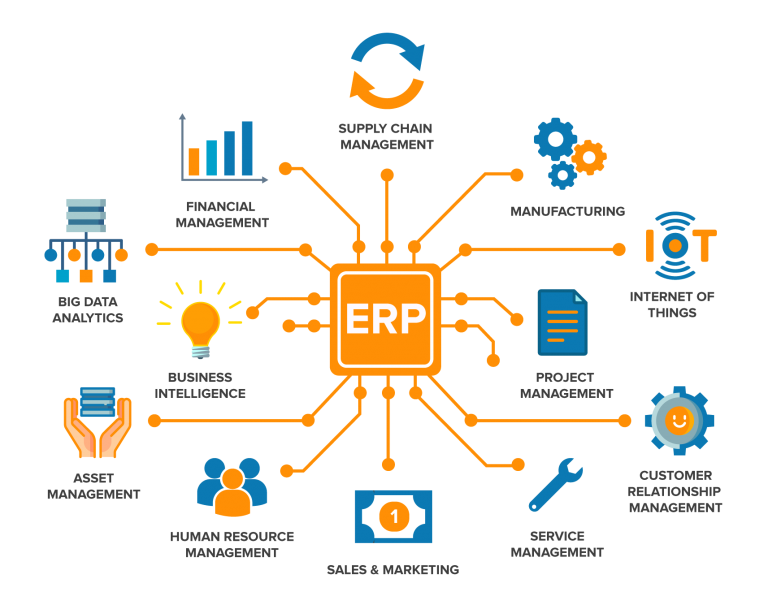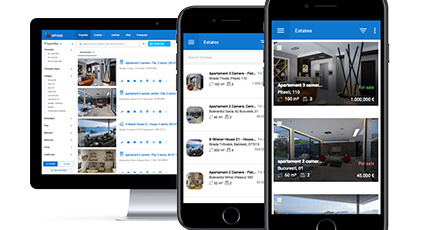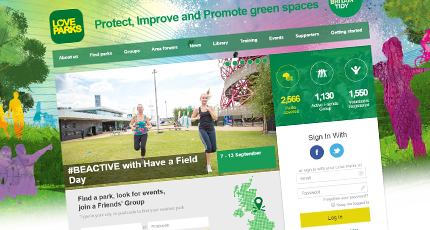Enterprise software systems help medium and large companies solve broad-scale problems and usually are too complicated for individual business use. This type of software handles many operations within a company to facilitate its business and management reporting. They’re designed to increase speed, scalability and deploy across various networks, like the internet, intranet, and corporate networks.
If you want to read more about what makes an enterprise application “enterprise”, read the article here.
The development of such complex software systems is outsourced to specialized companies. Mainly because it is not efficient to deploy the development of enterprise software to in-house IT specialists. Internal IT teams do not possess the necessary skills or know-how, nor the tools, to face unseen developing problems that will surely arise (read more about it here).
#1 ERP – Enterprise Resource Planning

source: https://actech.af/erp-system/
In this digital-driven era, most companies keep their clients’ database, do their inventory management, or process orders using… Excel. A study conducted by Deloitte in 2018 showed that 62% of executives still use Excel spreadsheets for insights.
This approach has multiple problems, but one stands out – the dependency on the human factor. This means that the data comes with delays and errors, which will lead to revisions and even financial loss.
As the business grows and the processes increase in complexity, using an Excel spreadsheet will slowly become less relevant.
ERP systems are considered to be the heart and brain of a modern company.
These systems create a unified database with very few errors. The data is entered by each department inside a system that can give any company a 360° overview of its clients, automate business processes and get valuable insights of what to improve.
Which departments can be integrated within an ERP system:
- Accounting;
- Inventory management;
- Customer service;
- Business process management;
- Order management;
- Human resources;
- E-commerce;
- Shipping, etc.
Are you interested in creating your own ERP system?
#2 CRM – Customer Relationship Management

source: https://www.reallysimplesystems.com/blog/do-i-need-a-crm-system
The market for CRM software is the fastest growing out of all enterprise softwares. But there is no surprise. A study shows that the average ROI for CRM is $8.71 for every dollar spent and it can boost conversion rates by a staggering 300%.
Why does this happen? Because a CRM system ensures your sales and marketing team is aware of every client, regardless of its size. It allows sales representatives to track how they interacted with a client during its lifetime with the company (in person, phone, email, social media, etc.) and can be sure that every lead is valued at its maximum.
Most CRM systems help track leads, manage orders, engage with your clients, track their status, plan advertising campaigns, and evaluate their effectiveness.
One of our clients, a real estate company from Bucharest, which has its key-differentiator embodied in the concept “exclusive representation” (the focus is on gaining customers’ trust through full transparency and clear agreements), needed a custom CRM integration and a website. In order to fully support their business statement, we delivered a solution that has:
- custom design;
- social media and blog integration;
- video testimonial feature;
- CRM system integrated with the website;
- custom functions that would simplify the management of every agent operation;
- custom user login for properties’ owners;
- custom favorites functionality;
- automated properties import from FlesmIs;
- a custom version of our WHISE CRM web service (enabling our client to manage properties, contacts, emails, and reports easily).

#3 HRM – Human Resources Management
The power of HRM is that it helps automate routine tasks like payroll management, workforce planning, performance management, payroll, employee training and engagement and hiring.
In the same time, HRM helps accomplish the strategic business goals by having a more comprehensive approach to managing people, workplace culture and environment. It enables employees to effectively and productively contribute to the overall direction of the business.
An HR department with HRM software can provide the knowledge, necessary tools, training, administrative services and more, all of which help the company to have a smooth and successful operation.
One of our clients asked us to optimize the existing HR platform by implementing smart technologies that are able to eliminate redundant and time-consuming activities (for all users types: recruiters, employees, candidates) and provide an optimized user experience through intuitive design, tools, and features.
We optimized the software and completely changed the user interface in terms of design and usability. The main challenge was the high volume of legacy code that needed to be replaced. The key result: we created a fast, high performing and easy manage/use vendor management system that includes:

- candidates’ profiles management;
- message board;
- jobs’ submissions, approvals, outsourcing status, locations, and rates;
- placements’ status, starting and ending dates;
- timesheets, time logs, and approvals;
- invoices – payment info, no. of hours, rates, expenses, shifts and approvals.
How did Roweb managed to deliver such complex enterprise solutions?
TECHNOLOGIES THAT WE USE:








METHODOLOGIES
- Agile
- Scrum
- Kanban
- Waterfall
ROLES WE PROVIDE
- Project managers
- Business analysts
- Developers
- Q&A specialists
- Scrum masters
- UX Designers




